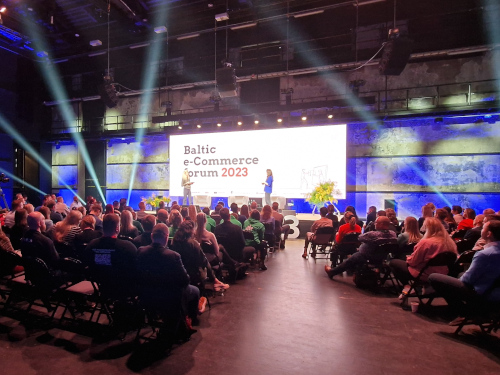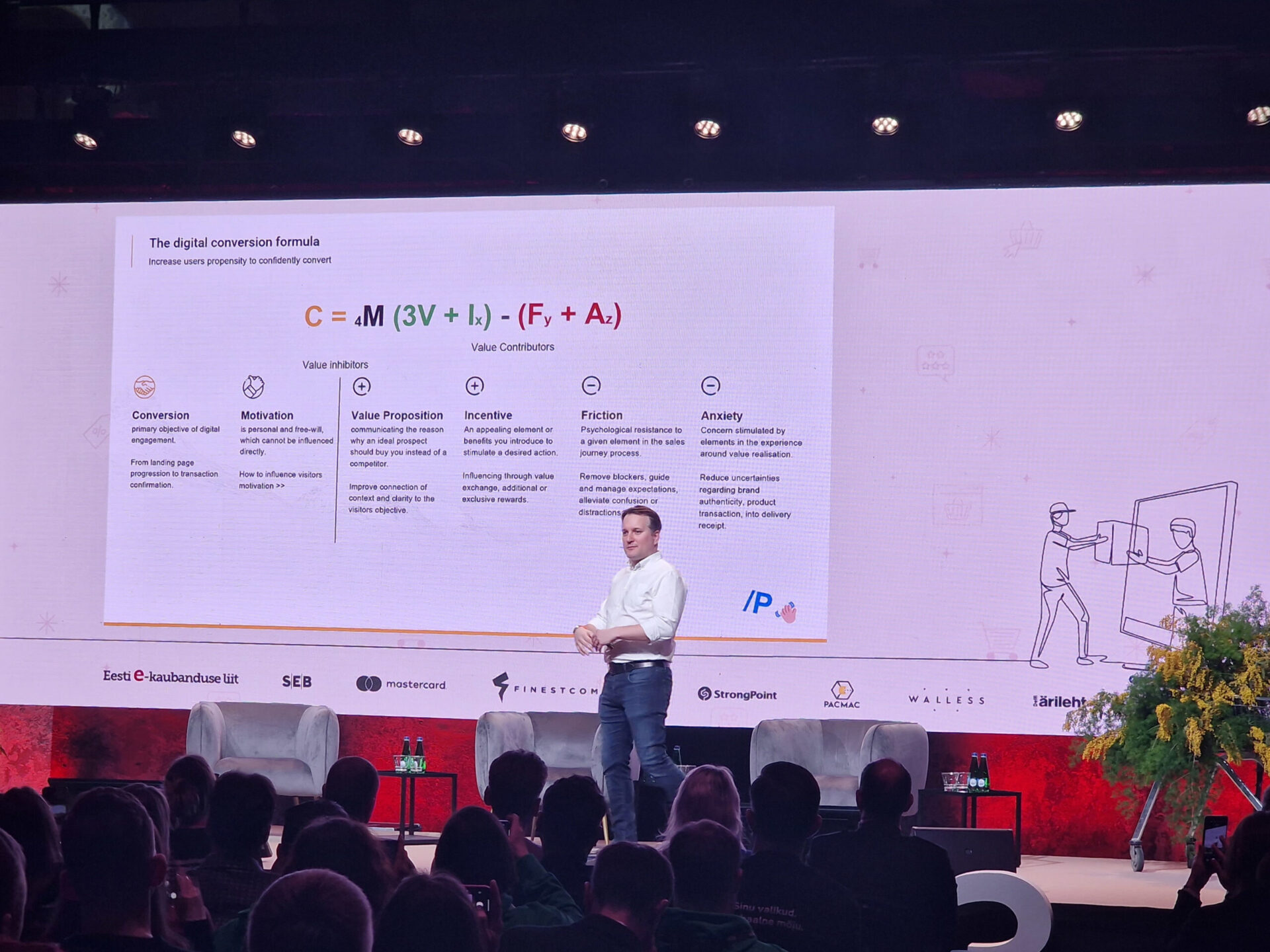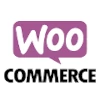

On March 14, another major Baltic e-commerce event took place: “Baltic e-commerce forum”, where this time a very exciting group of participants spoke.
The forum was visited by our e-commerce manager Aldar Reinberk, who made a short summary of the presentations. In summary, not all of the presentations have been covered, but only those that were more interesting and seemed to be useful to the reader as well.
In summary, it must be said that this year’s big event organized by the E-commerce Union once again brought only positive emotions. The events organized by the E-commerce Union have become increasingly professional and representative each year. Strong experts in the field spoke on stage, both from Estonia and abroad. And many strong service providers were represented in the Expo area.
For example: Adobe Commerce, Klevu, a search and recommendation engine based on machine learning, Venipak, which offers delivery solutions, Woola, a producer of environmentally friendly packaging materials, Kliendichat Askly, FinestCommerce, which offers technical solutions for e-shops, DHL, which offers cross-border delivery, etc.
A novel solution in the market of parcel machines
Venipak’s parcel machines are unique in Estonia, allowing customers to receive parcels without contact. Customers receive an SMS with a link to a QR-code, after which the QR-code must be shown to the camera, which then opens the machine’s door. The customer does not need to enter any information, but simply display the code to open the door. However, in order to use the QR code, the phone must have an internet connection – but who wouldn’t have it today? In addition, of course, the locker can also be opened with a PIN code.
See here the QR code-based Business Lounge and Fast Track ticket purchase system created by Acty for Tallinn Airport.
Why do customers leave our page?
Henry Burr of the Spirit, turned our way of thinking upside down. Instead of asking “why customers leave our page” we should ask “how to get them to buy from our page”.
For this, we need to create a better value proposition and additional incentives, increase the ease of use of the e-store by removing obstacles from the shopping journey, and address customer doubts already the purchase process.
Henry Burr also introduced a very interesting conversion formula in his presentation, which I won’t detail here. You will have to contact Henry directly to find out. But I will outline its general formulation.
How to enter a large market
- Find the right channels for you and focus more precisely on the target group to optimize marketing costs.
- Due to higher competition, the cost of advertising paid for certain keywords is almost 10 times higher. And simply throwing money at digital advertising is not sustainable for many Estonian companies.
- Be crafty and creative in developing marketing plans and ideas.
How to launch your brand on Amazon?
- Andrejs first debunked the myth that successful selling on Amazon is limited to markets where Amazon has a physical presence. He emphasized that successful sales can occur in other markets as well, citing Estonia as a prime example.
- It is very important to do proper preliminary work and explain exactly what the buyers require. For such statistics and analytics, Amazon has several tools to help you find popular keywords and analyze product sales potential, competitors, trends, and customer statistics.
- Also on Amazon, first of all, you have to pay for advertising.
- To stand out from the competition, you must have a distinctive offer. The most important thing is to pay attention to the content, so that there is enough adequate and interesting content about your products and your company, which would be valuable both to Klein and the Amazon indexing engine.
- Think about your buyer and prepare your message and sales offer accordingly.
E-commerce logistics 2023
In her presentation, DHL board member Kristina Laaneots brought out many interesting statistical facts about consumer expectations and preferences for delivery methods.
- DHL estimates that cross-border e-commerce will grow at least four times in the next two years.
- There are permanent changes in consumer behavior and at least 35% are ready to pay more to choose more convenient delivery services.
- 49% of buyers have abandoned a purchase because of an inconvenient or slow return policy.
- 68% of Generation Y choose a merchant purely based on the delivery methods offered.
- Monitoring the progress of the goods is especially important for buyers in cross-border trade, ensuring they can track the current location of their ordered goods with certainty.
- The delivery process should be viewed together with the overall customer experience, in which the delivery process is a large part of the customer’s satisfaction with the merchant.
- 42% of shoppers plan to do their Christmas shopping earlier than usual to avoid higher prices and longer delivery times during the holiday season.
- 62% of buyers say that the speed of delivery has a significant influence on their purchase decision.
- The importance of sustainability for buyers
- 42% are ready to pay more for environmentally friendly delivery solutions.
- 83% have expressed intent to prioritize sustainable brands and environmentally friendly products when making energy purchases.
- DHL board member Kristina Laaneots recommendations:
- Specify now Zon the website that you offer international delivery.
- Offer sufficent different delivery methods, including Express service.
- Don’t hide shipping charges.
- Make the customer’s shopping experience as easy as possible.
- Create a convenient return option.
7 ways to increase the profitability of your e-shop
Lauri Post from Wunderfront talked about how to increase the profitability of your e-store and outlined 7 methods of how to do it, listing a number of necessary tools. You can download the list of tools from the Wunderfront page.
How to multiply sales with SEO?
Jaanus Lahe from Convertal pointed out several important myths, statistics and advice about search engines and positioning in them.
Interesting facts about search engines:
-
- 68% percent of shopping journeys start from a search engine
- The first three results of the search get 54.4% of the clicks.
- SEO delivers 1000+% more traffic than organic social media.
- 58.99% of all web traffic comes from mobile phones.
- SEO can be complicated and there are over 200 factors that determine your position in search.
- When competing for search positions in large markets, you have to be smart and very focused on specific keywords.
- 99.5% of Google users do not click on the results beyond the second page of a search.
- SEO myths:
- SEO is expensive – No, it depends on your starting point and how tight the competition is for your keywords. Good content created for the right keywords can be enough for SEO.
- Backlinks are dangerous and Google can block your page – No, backlinks are very valuable, but they should not be bought from random pages.
- SEO is a one-time job – No, SEO requiers ongoing efforts because competitors don’t sleep either and search engine algorithms change over time.
- There must be a lot of content and a lot of keywords.
- Interesting thoughts to take with you:
-
- The cost of high quality backlinks may seem intimidating but they are worth it.
- Blog posts built on an important keyword also bring important traffic.
- Google likes longer and well thought-out blog posts that are interesting to read.
- Organic traffic yields is the highest quality results relative to sales.
- Don’t do SEO just for yourself, prioritize the client’s needs
- Provide value with content and support the purchase journey.
- Choose an SEO strategy. Don’t try to solve everything.
- Organize your Google Analytics.
Shoppers post-COVID-19 have completely changed
Neuromarketing Lab founder Kristian Pentus pointed out the characteristics of consumer behavior that have changed since the COVID-19 pandemic.
- Four main reasons why people are permanently committed e-traders:
- Convenience.
- Efficiency.
- Security.
- An enjoyable experience compared to a normal shop.
- After the COVID-19 pandemic, consumers are more demanding and more confident in their choices, but at the same time less focused, more hectic and act more hastily.
- Importantly, the variable is customer profiles. The number of buyers in the 40+ age group has grown significantly among shoppers.
- And most importantly, the post-COVID-19 shopper expects perfection from the seller.
- Emphasis must be placed on image quality. Product images must be true and fair. 22% of returns are made because of an image that left the wrong impression.
- The buyer expects speed and accuracy. Speed in both delivery and communication. And this both in the pre- and post-purchase process. 84% of buyers are more likely to buy if you have a clearly communicated return process.
- Traffic from mobile phones has increased dramatically. Buyers expect your mobile site to be perfect.
- Brand loyalty is no longer as strong as it was before COVID-19. Representatives of Generation Y and Z quickly abandon brands if the experience they receive is not ideal.
- The importance of reviews has grown even more. The post-COVID buyer makes purchasing decisions based on honest feedback from other buyers.
- Data security is very important for customers. The buyer must be convinced that your site is secure. And if your e-shop does not look neat and professional, the buyer will subconsciously conclude that your site security is not good either, and will choose a competitor.
- The buyer expects flexible payment solutions. Offer more options, especially if you sell internationally.
- The behavior of shopping in a physical store has also changed. Buyers are increasingly obtaining information about competing offers while they are in a physical store, as opposed to when they are surfing on their mobile phones.
- In summary, the post-COVID-19 buyer expects their customer experience to be convenient, fast and pleasant.
Are you ready for the Accessibility Act to come into effect?
- There are a total of 1.3 billion disabled people in the world.
- In 2025, the “European Accessibility Act” will enter into force in the European Union, the purpose of which is to support the navigation of websites for visually impaired people.
- Essentially, this means that technically, e-traders must change their website in such a way that the website is easily navigable with a keyboard and a screen reader.
- Today, 97% of the web has accessibility problems.
- In addition to screen readers and special keyboards, disabled people also use screen magnifiers, eye position detectors, and speech processors as aids.
- You can use a free tool to test your web accessibility: https://wave.webaim.org
Personalized shopping experiences
- Personalization means providing customers with the right messages, at the right moment throughout the purchase process, using customer behavior and profile data.
- 71% of B2C customers and 73% of B2B customers expect personalized experiences and prefer companies that do it well.
- 76% of customers get frustrated when they can’t find what they are looking for on the page.
- Proper personalization can increase…
- 10 times the conversion rate.
- turnover per customer 8 times.
- 9 times the average shopping cart value.







